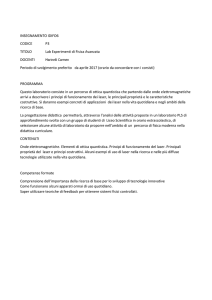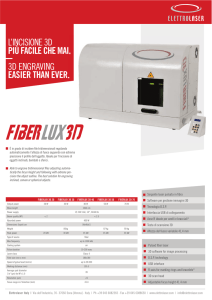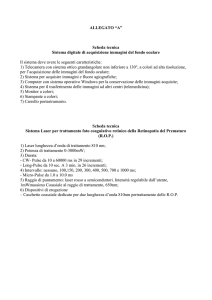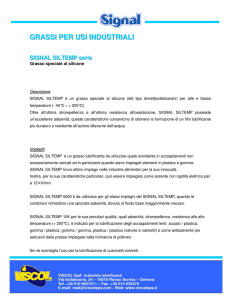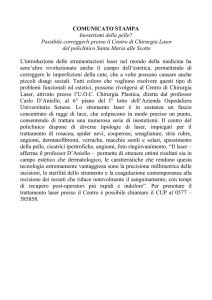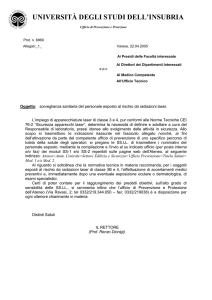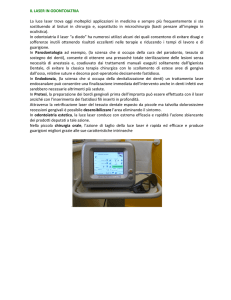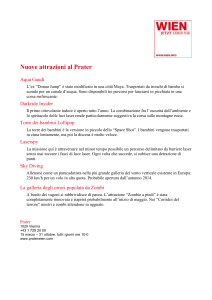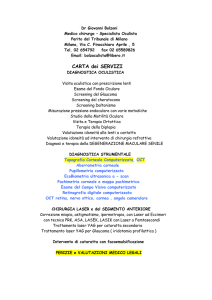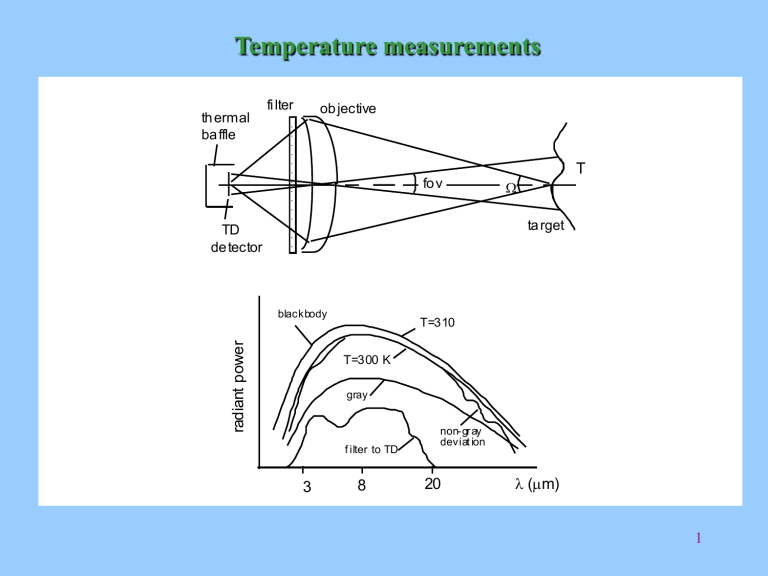
Temperature measurements
th ermal
ba ffle
fi lter
ob jective
T
fo v
ta rget
TD
de tector
radiant power
blackbody
T=310
T=300 K
gray
f ilter to TD
3
8
non-gray
deviat ion
20
(m)
1
Noise
In a BLIP-limited detector:
in(bg) = s NEP = sNA√AB/DBLIP
= NA√[2pes r()DAB]
but signal is
then
i = sDp = s pNA2 A Dkr() DT/T
S/N = k(DT/T) NA √[psAr()D/2eB]
and the NEDT - noise equivalent differential temperature DT @ S/N=1:
NEDT = (T/kNA) √[2eB/spr()DA]
= 2kT2 DBLIP (1/hNA)√(B/A)
2
Theoretical NEDT
-1
10
6 107
8
6 10 8
MINIMUM DETECTABLE TEMPERATURE
NEDT (°C)
5
3
2
-2
10
9
8
6 10
5
3
h=0.5, NA=0.5
A=0.01 cm2
DBLIP =6.1010
2
-3
10
8
5
3
10
D** = 6 10
2
-4
10
8
D BL
5
IP
(W-1cm√Hz)
it
lim
3
2
-5
10
1
10
10 0
1k
10 k
BANDWIDTH B - (Hz)
3
NED in real detectors
If detector is real (not BLIP-limited):
in(bg) = s NEP = sNA√AB/D**, signal is the same
S/N = Di/in(bg) = pNA √(A/B) k r() D(DT/T) D**
and
NEDT = T [pNA k r() D D**]-1√(B/A)
= 2kT2 (D2BLIP/D**) (1/hNA)√(B/A)
4
Thermovisions
Spectral range of operation: MIR, =3-5m or FIR, =8-14m
GENERATIONS:
0-th: pioneer’s work: Spectracon (oil -film camera), 1950
1st: LN-cooled InSb scan camera (AGA, Huges, etc.) 1970 - general purpose
2nd: LN-cooled CMT and LTT FPA, 1980 - military
3rd: TEC-cooled Bolometer, 1985 - portable
4th: uncooled Pt-Si and VOx bolometer 1990 - camcorder
5
Optical preamplification
Ps
I ph
G
G Ps
Optical power gain is G. At output, added to amplified signal GPs a dc
power due to amplified spontaneous emission is found:
ASEout = nsp(G-1)hnDn0
6
OA noise equivalent circuit
Ps
I ph
G
Pu
ASE i +
+ 2 hn ASE i B
2(F-1) hn Ps B
Noise input: ASE shot-noise plus
excess noise (factor F)
Pu = GPs + GASEi
s2Pu = 2F G2 hnPs B + 2 hnG2ASEi B
7
AO performance
30
9
G
20
6
G(dB)
F(dB)
10
3
F
0
best range of operation
-40
-30
-20
-10
0
+10
0
P i (dBm)
Performance is typical for EDFAs, 1480-1540 nm
8
Requirements for OA preamplification
• SIGNAL LEVELS:
ASEi limits minimum signal amplitudes
Pi=1÷10W (or -30÷-20 dBm).
Onset of saturationis at about 1-10 mW
• WAVELENGTHS:
a few available, in correspondence to
laser lines (e.g., 1500, 1300, 1060, 850 nm)
• SIGNAL MODE:
a single spatial mode is required, or the low
coupling hto DFA fiber would frustrate any
amplification
• Large PIXEL #:
extension theoretically feasible but not yet
demonstrated: problem is that, in AO with N
modes, ASE increases N times becoming very
high for images with N =105..106 pixels
9
Il Fotomescolamento (rivisitazione di una vecchia tecnica !)
LASER 1
Potenza
ottica
E1=E01cos(2pf1t+1)
fibra o guida
ottica
controll
polarizz
f1
f
I(t)E1+E22 = E12
+E22+2E1E2cos[2p(f1-f2)t +1-2]
Fotodiodo
a
larga banda
LASER 2
Potenza
ottica
accoppiatore
f2
f
out
Potenza
elettrica
E2=E02cos(2pf2t+1)
f1- f2
f
10
Il Fotomescolamento, II
per rilassare il requisito di stabilità di frequenza dei due laser,
é meglio usare un laser a 2 modi oppure in regime di mode-locking
laser a 2 o piu' modi,
meglio se mode-locked
con spaziatura Dn
uscita elettrica
a frequenza Dn
(typ. 60 GHz)
fibra o guida
fotodiodo
ultrarapido
infine, e’ opportuno incidere sul fotodiodo con la potenza ottica più
alta possibile, inserendo un amplificatore ottico al posto della guida
11
Limiting resolution
1
MTF
0.5
limiting
resolution
0.03
0
0
k - spatial frequency
A generic MTF diagram always
starts from MTF=1 at k0 (low
spatial frequency), and gradually
decreases to zero at increasing
spatial frequencies.
The cutoff frequency is defined
as that of eye perceptivity to
contrast, Clim=0.03, and the corresponding spatial frequency is
calledlimit spatial frequency (or,
limiting resolution).
12
Optical rule circuits
RIFARE
cos signal
sin signal
sin
cos
I
I0
0
p
2p
x
By counting the sin
and cos crossings of
mean level I0, (4 per
period) displacement is
measured with p/4
resolution (and sign)
13
Infrared MSA
k
N rows
M columns
+V bb
j
k-column
j-row
video
out
Y
metal
Y
Y'
VO X
bolometer
X
X
B
E
Y
readout
metal
14
Classification
near-infrared
viewers
1st, 2nd, 3rd
generation types
for
radiology
in visible (IMAGE INTENSIFIERS or IIT)
or infrared, UV (IMAGE CONVERTERS or ICT) and X-rays
ELECTROSTATIC or MAGNETIC focalization
electron ENERGY or electron NUMBER amplification
special functions can be included: gate, zoom, sweep
hand-held
night visors
and LLLTV
bulky, for
astronomy
with
MCPs
fast (ns)
shutters
streak
cameras
15
Magnetic focussing ICT
FOC USIN G COIL
PH OTOCATH ODE
ELEC TRON TR AJEC TOR IES
PH OSPHOR
GLASS
WIND OW
FAC EPLATE
AXIAL FI ELD R INGS
GLASS
WIND OW
FAC EPLATE
+V
0V
bb
(typ. 15 kV)
16
ICT parameteres
Spectral response : all transmission PhC available, with preference of
S-20 and S-1
Display characteristics : phosphor P-20 is preferred, has medium
persistence (0.35 ms), good yield(k=80 ph /keV)
Radiant gain G=Eu/Ei: reference source is the 2850 K lamp (as representative of artificial illuminance and of residual
illuminance of natural scenes at dark
Response dynamic range : ratio of max. to min. reproduced illuminance, is given by Esat/GICTEBI, where Esat=screen
saturation level, GICT=gain and EBI=equivalent
background illuminance (typ. 10-7 to 10-4 lux)
Linearity : Eu=KEi can reach a conformity better than 1% for an individual pixel, but from pixel to pixel K may vary
over ±10%, because of PhC and PS disuniformity
Spatial resolution : is described by the MTF; total limiting resolution is
about 50 cycles/mm.
17
Photodetectors Devices, Circuits and Applications '
by: S. Donati, Prentice Hall, USA, 2000
XVIII+425 pages, bound, price:75$, ISBN 013 020337-8
see web: http://www.phptr.com/booksrch/index.html
or buy online from: http://vig.pearsoned.com/store/product/
18

